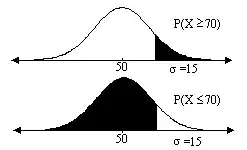I was searching on this forum to calculate the p value from a t.test score.
So I found this topic.
The answer giving:
> 2*pt(ttestscore, lower=FALSE)
However it makes no sense to me using the lower = FALSE.

When using the lower = F argument you will calculate the probability of the black shaded area in the second figure right?
This means that you are calculating the probability that the t score is LESS then the giving t score, but you want to calculate the probability that the T score is bigger (if you are giving the t score as a positive number)?